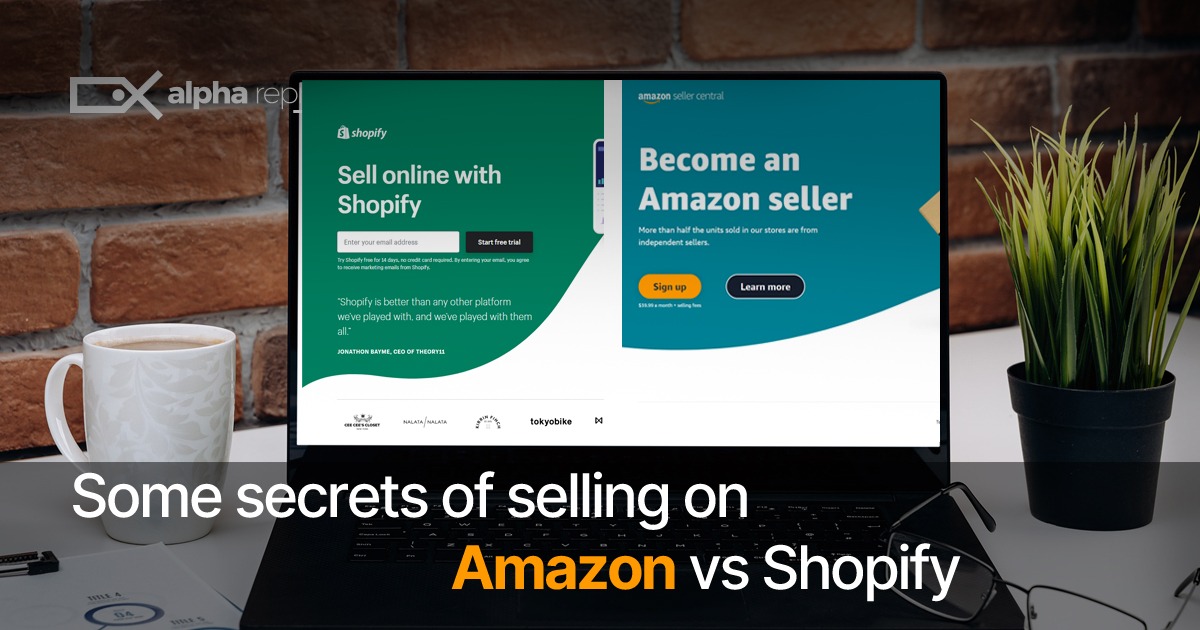Expert Comparison: Secrets of Selling on Amazon vs. Shopify
When it comes to eCommerce businesses, two major eCommerce giants cannot be ignored: Amazon and Shopify. Deciding which platform to use is one of the most important decisions for sellers when taking their products online.
Both platforms are successful and have established their reputations in the online marketplace, with Shopify powering over 4.6 million live stores worldwide and Amazon receiving 2.5 billion visitors monthly. In this article, you’ll learn more about Amazon and Shopify and how you can start selling on Amazon via Shopify.
Alpha Repricer, also known as fastest Amazon repricing tool is here to help you decide whether to go for Amazon or Shopify; keep reading!
Fundamental Differences Between Amazon and Shopify
These two leading platforms come with their own advantages and disadvantages:
- Amazon is the largest online retailer globally, focusing on gaining customer trust and satisfaction. On the other hand, Shopify excels in providing sellers with complete control over their store but has not attracted as many direct customers to buy products.
- In our professional opinion, when discussing pricing strategies, Amazon can be quite expensive for new sellers to start. Conversely, selling and buying products on Shopify is generally more cost-effective.
- Amazon’s customer support is renowned for resolving queries quickly. In contrast, newcomers on Shopify may find it challenging to get their issues resolved promptly.
- Amazon offers Fulfillment by Amazon (FBA), which picks, packs, and delivers products to customers. Shopify, however, does not offer any fulfillment service, requiring sellers to manage this aspect independently.
- Amazon allows sellers to market their products in various unique ways, while Shopify requires more effort to sell and build product visibility.
Pros and Cons of Shopify
Pros:
- Efficient features for blogging to boost SEO.
- Higher profit margins.
- Complete ownership of your store and product image.
- Fewer restrictions for sellers and buyers.
- Numerous payment methods for reliable transactions.
Cons:
- Challenging marketing.
- Limited theme templates.
- Less exposure for products.
Pros and Cons of Amazon
Pros:
- Excellent services, including customer support and FBA.
- Easier to brand and market products.
- Instant credibility and customer trust.
- The high influx of sellers, with over 2.5 million joining annually.
Cons:
- Bound by strict rules and restrictions.
- Lower profit margins due to various fees.
How to Start Selling on Amazon via Shopify
Connecting Shopify with Amazon requires your Shopify account to meet specific criteria:
- Activate your Amazon account.
- Ensure prices are in USD.
- Use Fulfillment by Amazon.
Steps to Start:
Add Amazon as a Sales Channel:
- Log in to your Shopify account, click the + icon beside “Sales Channels,” and select Amazon.
- Click “Add” to confirm.
Register as a Professional Seller:
- Create a Professional Seller account on Amazon Seller Central.
- Fill in necessary information like name, address, and email address.
Get Approval:
- Apply for approval from Amazon to ensure your items fit the categories.
List Your Items:
- Create listings on Shopify. Click on “Amazon” under the sales channels section and create listings by selecting products.
Set Inventory Tracking Policy:
- Choose to use your store’s inventory or manually manage your Amazon inventory.
Start Selling:
- Complete the setup and start selling on Amazon through Shopify to target a wider audience and increase profits.
- To learn how you can target your audience on Amazon, read our blog!
Which is Better: Amazon or Shopify?
For eCommerce businesses, both platforms offer unique benefits. Amazon requires adherence to strict rules and multiple fees, which can impact your control over the business. However, it provides an established customer base and credibility.
Shopify allows complete ownership of your brand, with more affordable fees and flexibility. However, it demands more effort in marketing and competition monitoring.
Conclusion
Both of these e-commerce giants have their pros and cons in the eCommerce marketplace. Amazon is a major global retailer, while Shopify offers a personalized store experience.
In our opinion, if you seek complete control over your marketing efforts and business operations, Shopify is a better choice. However, if you are comfortable with higher fees and some limitations in exchange for a vast customer base, Amazon could be the right platform for you.
At Alpha Repricer, we offer the fastest real-time repricing to keep your prices competitive. Our tool is designed for Amazon sellers, repricing as soon as changes are detected, with affordable and efficient pricing plans. Try our tool now!
Author
-
Meet Noor Jarri, a seasoned writer specializing in the dynamic world of Amazon. With over three years of experience, Noor has become a trusted resource for Amazon sellers seeking guidance on repricing strategies and navigating the e-commerce landscape.
View all posts
As a valued contributor to Alpha Repricer, Noor's expertise shines through in her engaging blog articles, press releases, and guest posts. Praised for her skill in crafting content that is both informative and approachable, Noor's writing is a knowledgeable resource for sellers of all levels. Beyond her professional pursuits, Noor is an avid traveler and culinary enthusiast. She finds inspiration in exploring new destinations and experimenting with recipes from around the world.
Join Noor Jarri on her journey as she continues to empower Amazon sellers with insights, tips, and strategies to thrive in the ever-evolving marketplace.
Noor Jarri
As a valued contributor to Alpha Repricer, Noor's expertise shines through in her engaging blog articles, press releases, and guest posts. Praised for her skill in crafting content that is both informative and approachable, Noor's writing is a knowledgeable resource for sellers of all levels. Beyond her professional pursuits, Noor is an avid traveler and culinary enthusiast. She finds inspiration in exploring new destinations and experimenting with recipes from around the world.
Join Noor Jarri on her journey as she continues to empower Amazon sellers with insights, tips, and strategies to thrive in the ever-evolving marketplace.





